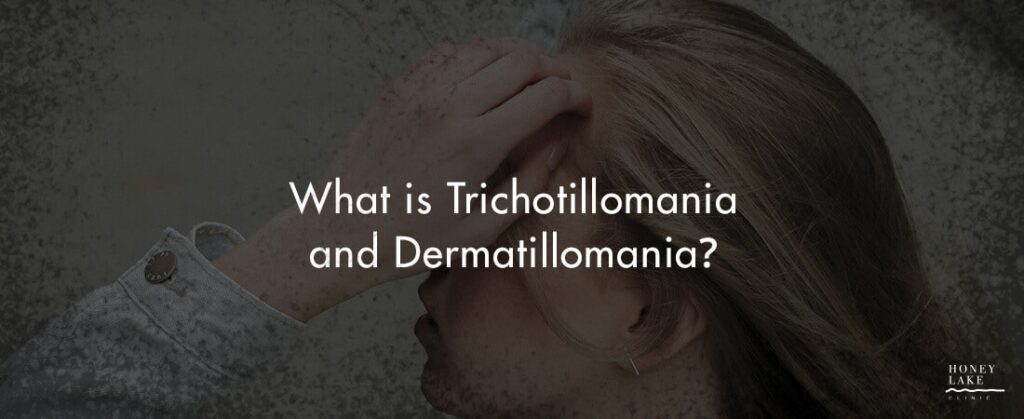What is Trichotillomania and Dermatillomania?
You might not think of picking at skin imperfections or plucking out unwanted hair as a mental health concern. For people suffering with trichotillomania, a hair-pulling disorder, and dermatillomania, a skin-pulling disorder, these behaviors can begin to disrupt their lives, cause distress and shame, and even result in the permanent discoloration of skin and scarring.
Trichotillomania and dermatillomania are both body-focused repetitive behaviors categorized under Obsessive-Compulsive and Related Disorders in the Diagnostic and Statistical Manual of Mental Disorders, Fifth Edition (DSM-5).
Trichotillomania and dermatillomania are serious health concerns. If you or someone you love is battling these conditions, we can help.
Symptoms of Trichotillomania and Dermatillomania
Hair-Pulling Disorder Symptoms
People with hair-pulling disorder may pull hair from their scalp, eyebrows, eyelashes and other areas. They may develop rituals around their hair-pulling such as biting, chewing or eating it.
Symptoms of trichotillomania include:
- Recurrent pulling out of one’s hair resulting in noticeable hair loss
- An increasing sense of tension immediately before pulling out the hair or when resisting the behavior
- Pleasure, gratification, or relief when pulling out the hair
- The disturbance is not accounted for by another mental disorder and is not due to a general medical condition (i.e., dermatological condition)
- Repeated attempts have been made to decrease or stop hair pulling
- The disturbance causes significant distress or impairment in social, occupational, or other important areas of functioning. Distress may include feeling a loss of control, embarrassment, or shame and impairment may occur due to avoidance of work, school, or other public situations.
- Hair pulling may be accompanied by a range of behaviors or rituals involving hair. For example, individuals may search for a particular kind of hair to pull or they may try to pull out hair in a specific way. Individuals might also visually examine or tactilely or orally manipulate the hair after it has been pulled (e.g., rolling the hair between the fingers, pulling the strand between the teeth, biting the hair into pieces, or swallowing the hair).
Skin-Pulling Disorder Symptoms
People with skin-pulling disorder may see skin imperfections that others don’t consider flaws. They may pick at their skin in an attempt to make the perceived imperfection look better. They may touch, rub, scratch or pinch skin until it bleeds and scabs. Sufferers may try to mask visible symptoms by covering the affected areas. In extreme cases, an individual may even withdraw from social interaction in an attempt to hide their disorder from others.
Symptoms of dermatillomania include:
- Compulsive skin picking
- Nails and cuticle picking
- Picking scabs
- Scarred skin
- Calloused skin
- Bleeding skin
- Swollen skin
Addressing Popular Misconceptions
It’s just a bad habit.
No, it’s not. People with skin-picking disorder or hair-pulling disorder feel urges well beyond the desire for everyday cosmetic fixes that many people feel.
People can just stop.
It’s not that easy. Simply deciding to stop pulling their hair or picking their skin isn’t an option for people with these conditions. Discontinuing the behavior is complicated by the fact that in some cases, people don’t realize they’re engaging in the behavior.
It’s a rare condition.
Not as rare as you’d think. Some data estimates up to 4% of the population experience trichotillomania at some point in their lives. That translates into millions of people. Skin-picking disorder is also common, affecting about 1 in every 20 people, according to the OCD Foundation. Many researchers believe that these statistics underestimate the prevalence of the disorder, as many suffering with these disorders don’t seek treatment.
Co-occurring Disorders, Underlying Conditions and Treatment
People with trichotillomania and/or dermatillomania are often diagnosed with one or more co-occurring mental health disorders. These may include anxiety, mood disorders, OCD and eating disorders.
Treatment for trichotillomania and dermatillomania should explore underlying issues. Like alcohol or drug treatment and recovery, addressing underlying issues which may directly or indirectly be contributing to the behavior is very important.
If you or someone you love suffers, take heart—we understand and we’re here to help.
The Honey Lake Clinic difference
At Honey Lake Clinic, our experienced staff, licensed therapists, psychologists, and psychiatric specialists understand that effective treatment for trichotillomania and dermatillomania requires a multifaceted, faith-based approach, involving healing of the body, mind, and spirit. Our unique treatment programs specifically and deeply address all three spheres, offering each client his or her greatest chance at wholeness and transformative growth.
This holistic approach and a combination of key factors makes Honey Lake Clinic’s mental health program different from the others in the country.
You’ll benefit from Honey Lake’s—
- Integration of a Bible-based approach and sound psychological principles
- Experienced, compassionate, and highly trained clinical staff
- Individualized treatment with a low caseload of patients per therapist
- Practical curriculum focused on decision-making mechanics and skills
- Emphasis on holistic healing of the mind, body, and spirit
